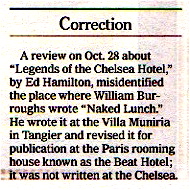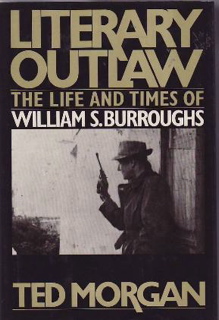I have no idea how many readers wrote to tell them. But I know of at least one. This was my email message to The New York Times Book Review:

One Legend Too Many
To the editor:
The Chelsea Hotel has so many legends attached to it one less won’t hurt. The Chelsea is not “[w]here William Burroughs wrote ‘Naked Lunch,'” as Jeff Giles puts it in his review of “Legends of the Chelsea Hotel.” (“Chelsea Mornings,” Oct. 28) Mr. Burroughs wrote the manuscript at the Villa Muniria in Tangier (at 1 Calle Magallanes, where Jack Kerouac typed up an early version for him) and at the Beat Hotel in Paris (at 9 rue Git-le-Coeur, where Brion Gysin and others helped him prepare a later version for publication).
I sent the email three Sundays ago, on the morning of the review. A few days later I received this automated reply: “Thank you for writing to the editors of the Book Review. We read every e-mail we receive, but cannot always respond. We will contact you if we decide to publish your letter.” Never heard from them again.
This morning they ran their correction, unattributed. If they had contacted me, I would have told them my correction was incomplete. And now so is theirs. A key section of “Naked Lunch” was written in a hotel in Copenhagen, as a friend reminded me, and as Ted Morgan writes in his peerless Burroughs biography, “Literary Outlaw”:

Burroughs left for Copenhagen in July 1957 … on an intuition that it would be important for his book. He had four main zones, or sets, where the book takes place — the United States, South America, Interzone (which was Tangier), and Freeland — and in Scandinavia he found the real model for his imagined Freeland, a place of the living dead. He had already described it as a series of bars along a canal, which was what he found in Copenhagen. What he saw exceeded the most ghastly product of his imagination. … The dead-level sanity and bone dullness of the Danes appalled him. It was a police state without police, populated by robots completely conditioned by the state. The only antisocial element was the juvenile delinquents, known locally as “Leather Jackets.” It was all horribly depressing, the sandwich bars, the workmen in overalls listening to classical music on the radio, the lack of conversation, the general inanity and squareness of the people.
… Scandinavia catalyzed the novel, which was now taking shape faster than he could write it down in his hotel room. Every time he reached an impasse, something happened to show him the way, so he stayed in Copenhagen through August and worked. The main theme, it was now clear to him, was the desecration of the human image by control addicts. As Lola La Chata, the Mexico City pusher, used to say, “Pushing is more of a habit than using.”
You think if I send this item to the Book Review — naturally with all due apologies to past, present and future generations of the Danish pipples — that the editors will run a correction to the correction?
Oh yeah.
(Crossposted at HuffPo)
Postscript: Colleen Thornton writes:
Thanks for shedding new light on an old legend. I had no idea that Copenhagen had made such an impression on William Burroughs, though in an entirely understated (typical) way. You see, I have lived in Copenhagen (København) for nearly 15 years and have, over time, found this so-called “sane” society quite NUTS. The whole country is suffering from an astonishing case of collective passive-aggression that occasionally erupts into overt aggression over things of which they are utterly ignorant; such as the world outside of Denmark, except the fictional reality of the USA.
While “Danish Design” is used to solve all sorts of problems here, it clearly has no medicinal effect on the junkies, drunks and prostitutes that live their colorful lives just yards from my doorstep.
Burroughs recognized the symptoms of the Danish disease alright. He’d not be surprised by how this “small country” has slid into social schizophrenia — self-medicating, self-congratulatory and utterly without self-awareness.
So much for the Danny Kaye version, eh?




